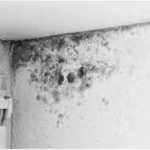The walls of the house are often moldy, peeling, and flaky after rainy days or prolonged humid weather. The appearance of dark spots or peeling paint on the walls not only affects the aesthetics but also the living conditions and health of the family members.
In addition to the humid weather, poor waterproofing during the construction process also contributes to the growth of mold and peeling walls.
Vietnam has a tropical humid and monsoon climate, with high average humidity. Therefore, prolonged humidity combined with poor waterproofing can easily lead to moldy and flaky walls.
Furthermore, low-quality paint or poor paint mixing techniques also affect the quality of wall paint during use.
To address this issue, you can consider some of the following methods.
How to deal with moldy walls
Use dry brushing method

When mold appears on the walls, you can use a dry brush to clean the mold spots first. Then, use a soft cloth soaked in alcohol to wipe the walls, preventing mold from growing. This method is effective if the mold spots are new and the area of moldy walls is not too large.
Use mold remover
Mix mold remover with water in a 1:99 ratio and pour it into a spray bottle. Spray the solution on the walls and let the mold remover work, making the mold spots on the walls fade. Then, you can use a brush to gently scrub the mold spots and wipe them clean with a cloth.
If the walls have heavy mold, you can make a stronger mold remover solution with a 1:20 mold remover to water ratio.
This method is suitable for recently appeared mold spots. For heavily moldy walls, you still need more professional treatments such as smoothing the walls with sandpaper, applying a waterproof primer, and then painting.
How to deal with peeling and blistering walls
First, the peeling and blistering areas need to be removed, and the putty layer should be scraped off. Next, smooth and polish the scraped areas of the wall with fine sandpaper. Finally, apply a layer of primer and a layer of topcoat.
If the blistering and peeling areas on the walls are large, after removing them, you should wait for the walls to dry before proceeding with further treatments.

During the treatment process, you must follow the construction regulations, pay attention to apply a waterproof paint layer at the base of the wall, and repair cracks on the walls.
Avoid painting the walls during the rainy season.
Use wall stickers, foam wall stickers

This is a temporary method, suitable for families without immediate solutions.
You can buy PVC plastic pieces, foam wall stickers, or wallpaper to cover the moldy and unsightly parts of the walls (remember to scrape off the swollen or peeling paint before applying).
This method has low cost and quick processing time, but it only solves the external aesthetics and does not address the underlying issue of damp and water seepage in the house walls.
Methods to prevent indoor humidity
Use dehumidifiers
You can use a dehumidifier to reduce indoor humidity.
In addition, using moisture absorbers, activated charcoal, lime, or dried tea leaves can also help absorb moisture and prevent humidity. Just put one of the mentioned ingredients in a small fabric bag, tie it up, and place it in every corner of the room to reduce humidity.
Close doors during humid seasons
During humid weather, you should close the doors and windows to prevent the house from “sweating”. On dry days, open the doors to ventilate and reduce the amount of moisture in the house.
Use air conditioning
You can use the air conditioner to dehumidify the house. When the air humidity is too high, turn on the air conditioner to dehumidify mode for 2-3 hours to reduce indoor humidity.
According to Khoevadep



































